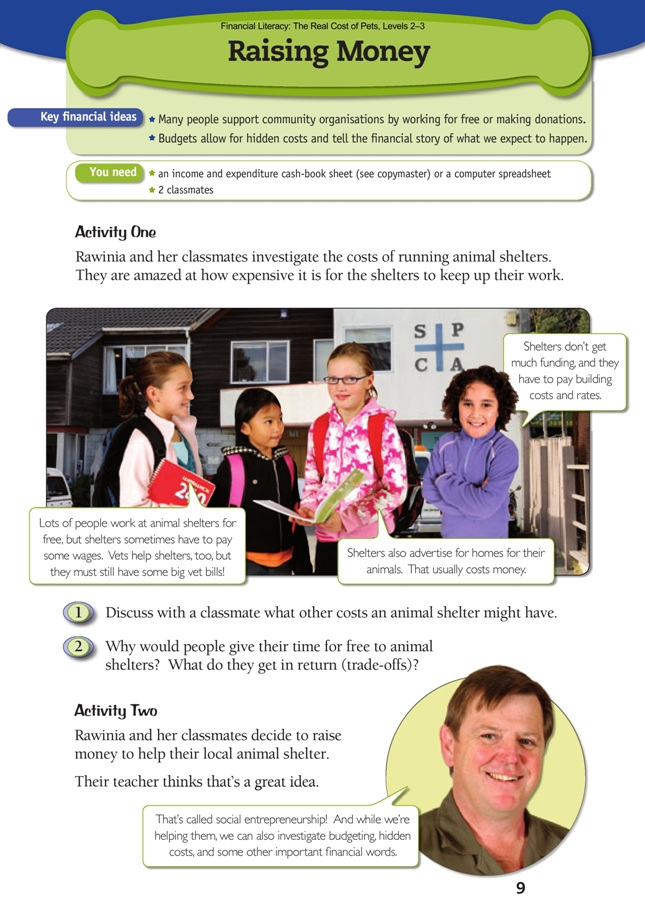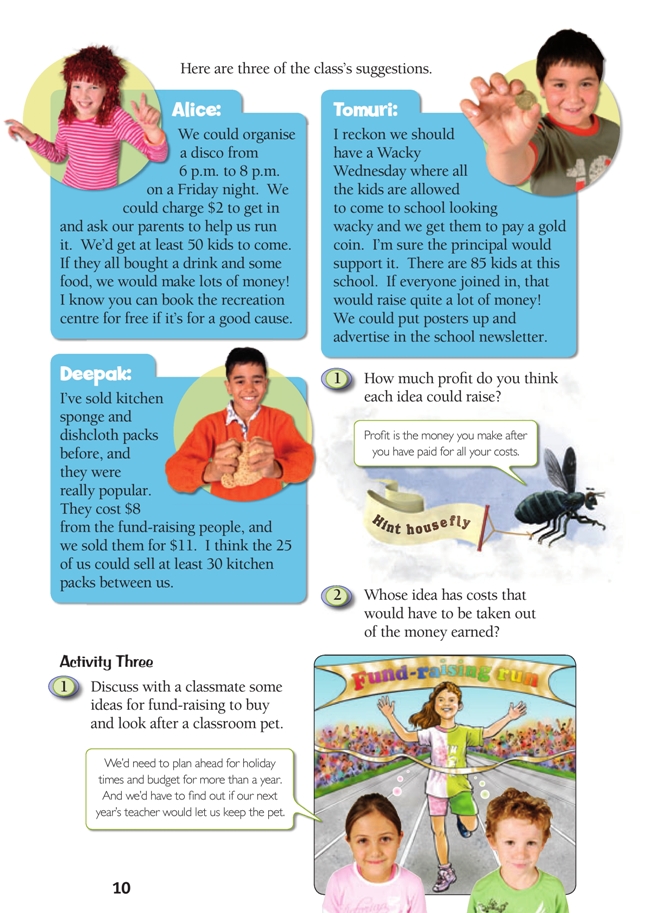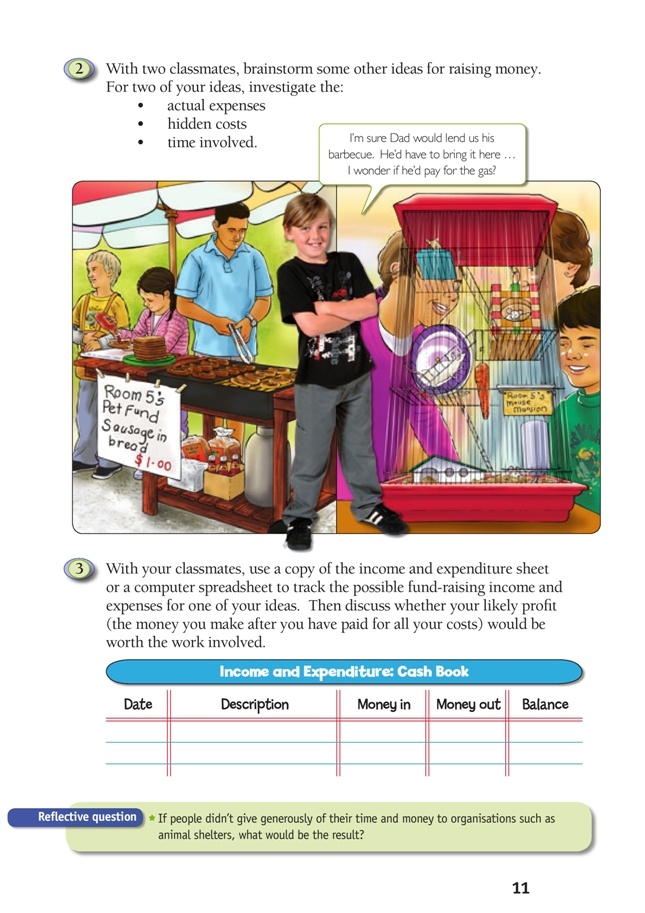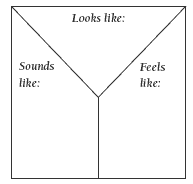This is a level 2 number and level 3 algebra activity from the Figure It Out series. It relates to Stage 5 of the Number Framework.
A PDF of the student activity is included.
Click on the image to enlarge it. Click again to close. Download PDF (3179 KB)
use additive strategies to add and subtract numbers to find costs and profits
use simple multiplicative strategies to solve problems
Number Framework Links
Students at stages 5 and 6 should be able to use numeracy strategies to solve the problems in these activities independently. (See the table of NDP material on page 4.)
An income and expenditure cashbook sheet (see Copymaster) or a computer spreadsheet
2 classmates
Activity One
Financial understanding
For the activities in Raising Money, the students need to clearly understand the financial definitions involved. You may need to explain what “rates” are in this context and why we pay them. The students may also need to revisit the terms and definitions introduced on pages 2–4 or via the wall poster (see copymaster).
This activity focuses on the fact that many community organisations rely on volunteers and donations to achieve their goals. The volunteers believe their “cause” is important, so they make a decision to work for no pay as part of their service to the community. They feel good about their contribution and are prepared to give up a
financial return for their time – a trade-off – even though it may mean sacrificing some wants. People’s financial decisions vary because of their different preferences.
Activity Two
Financial understanding
This activity teaches students that there are consequences from each financial decision they make and that successful fund-raising efforts bring a financial benefit to the organisation that is being supported. One consequence of carefully planned fund-raising that takes account of all costs is a higher profit to give away.
Some fund-raising efforts could be a lot of work for minimal return, especially if hidden costs such as time and personal petrol costs are not taken into account in the planning stage.
You will need to elaborate on the teacher’s speech bubble comments
about social entrepreneurship, especially if it is a term the students
have never heard before. Ask: What is normally meant by an entrepreneur? What might a “social entrepreneur” do? What is the difference? (One is for profit, the other
is for community benefit, but both have to demonstrate the same enterprising attributes if they want to be successful.)
Have you heard of any entrepreneurs who have also become social
entrepreneurs?
Who do you know who demonstrates social entrepreneurship? What
enterprising attributes are they showing?
This could also be done as a Y chart. (Divide a page into a big Y, and
have the students fill in the sections.)
Mathematics and statistics
Tomuri’s suggestion doesn’t involve any financial outlay, but both Alice’s and Deepak’s do. Ensure the students take into account the costs of these two fund-raisers, for example, for Deepak’s, to subtract the $8 from the $11 before calculating the profit on a single pack.
Activity Three
Financial understanding; mathematics and statistics
This activity links back to the investigation on page 5 into the feasibility of having a classroom pet. Here, the students learn that financial planning is important for personal and business financial success. This includes successfully managing the finances involved in having a classroom pet.
In this activity, the students learn that budgets and records of income and expenses are important documents that help tell the financial story of the plan and the transactions. Setting up budgets and records is an important part of planning for financial success. This is a good opportunity to encourage the use of spreadsheets for
budgeting, including using formulas for accurately updating balances.
Students engage in generating, identifying, and assessing opportunities when they come up with different suggestions for fund-raising ideas. They are identifying, recruiting, and managing resources when they create a project income and expenditure (budget) cash book for their fund-raising ideas. Ensure that your students
understand the terms in the cash book. As an extension, they could use a spreadsheet to manage the cash book.
Further investigations and tasks
The students could:
• research ways they could assist animal shelters apart from raising money, for example, giving their time to care for and exercise the animals or providing materials such as blankets or food.
• find a need within the community and collaborate on ways to meet this need. This could be social or financial. For example, a local beach needs to have rubbish cleared regularly, elderly people in the community need rubbish bins wheeled out and in each week, or, helping within the school, bigger buddies help junior students at lunchtime.
• research what other unpaid work is done in the class, school, or community, who organises this and who does it, why it is unpaid, and why it is necessary. They might consider periodic detention here.
• use their thinking from these activities to develop fund-raising ideas for school camps or other non-profitmaking organisations, for example, Canteen.
• discuss with family members and members of the community what community service they provide or have provided in the past that is unpaid/voluntary. This could include assisting within the family/whanau.
Social Sciences Links
Achievement objective:
• Understand how people make significant contributions to New Zealand’s society (Social Studies, level 2)
The students could follow the social inquiry suggested on page 19 into social action and implement what they have started.
In line with the research task above, the students could undertake a study of unpaid work within the school, community, town, or organisations, including asking: How does this benefit people, both the workers and the community? How and why has this changed over time?
Other Cross-curricular Links
English achievement objectives:
• Purposes and audiences: Show some understanding of how to shape texts for different purposes and audiences (Speaking, Writing, and Presenting, level 2)
The students could make a poster or a brochure for animal shelters.
• Language features: Show a developing understanding of how language features are used for effect within and across texts (Listening, Reading, and Viewing, level 3)
The students could create a mini-documentary or movie on a day in the life of a community worker.
Answers to Activities
Activity One
1. Answers will vary. For example, an animal shelter will also have to pay for food, power, phone, heating, equipment, cages, and transport costs if picking up animals.
2. Answers will vary, for example, the enjoyment of being with animals and looking after them, talking with other animal lovers, and the satisfaction of seeing animals going to good homes.
Activity Two
1. Answers will vary. There are no costs in Tomuri’s idea, which would earn $85 if
everyone gave a $1 coin and more (up to $170) if some gave $2. Alice’s idea could also earn them a good profit (for example, $100 from 50 entry fees, plus any profit on drinks and food) if the venue is free and they are not paying for music. Deepak’s idea could earn $90 or more.
2. The food and drink in Alice’s idea would have a cost and so would the kitchen packs in Deepak’s idea.
Activity Three
1.–3. Ideas and answers will vary.
Reflective question
Answers will vary. For example, the animal shelters wouldn’t be able to look after as many animals, and they would have to charge a lot more to re-home them; they might have to say to people who bring animals to them that they can’t take them in; a lot
more animals might be abandoned on roadsides or in parks or in deserted places.



